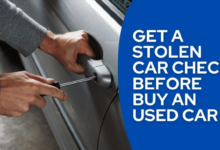If you’re looking for a reliable used car, you might wonder what to look for when checking if the used one has been stolen. This isn’t an impossible task, though. There are a few things you can do to avoid wasting time and money on a stolen vehicle. The first thing you should check is the car’s VIN number. If the number is scratched or removed, it’s a red flag that it’s been tampered with.
Find the vehicle’s VIN number
To begin, find the vehicle’s VIN. You should always check the VIN with the car’s title. If there’s an inconsistent VIN, you’ve found a stolen vehicle. A car’s VIN can appear on many different parts of the car, including the engine block, the dashboard, and the inside door. Ensure the VIN matches the seller’s name on the title and the car’s title. If it doesn’t, it’s a stolen vehicle.
Before you buy a used car, check the VIN. This information is useful when you’re shopping for a used vehicle. You can find out whether the car has been stolen by running a VIN history check. A VIN search can reveal details such as previous owners, accidents, and service records. A VIN check can save you time and aggravation by revealing information about a car’s past.
Ask the dealer for the car’s title and ask the previous owners about its ownership
To avoid a stolen car, try to find out more about the previous owner. Ask the dealer for the car’s title and ask the previous owners about its ownership. This will give you some information that may help you avoid a stolen vehicle. A clocked VIN and matching VIN/chassis numbers are additional clues to a stolen vehicle.
Check if it’s still on a PPSR
It’s important to check the car’s VIN to find out if it has been stolen. You can also check if it’s still on a PPSR. If it is, you can contact the seller and get the information.
Verify the details if you have doubts about the car’s theft
You should be able to verify the details if you have doubts about the car’s theft. A PPSR will tell you if the car’s owner has reported it to the National Insurance Crime Bureau.
Check the AUS Check website to see if it has been stolen
When looking for a used car, you can check the AUS Check website to see if it has been stolen. A VIN check will tell you if the car has been stolen, and you can also notify law enforcement.
If the VIN is associated with a stolen car, you should not approach the seller and report it to the NICB. This is a sure-fire way to avoid theft.
Check the vehicle’s history
While purchasing a used car can be a great way to save money, you should always check the vehicle’s history at auschecks.com.au before making the purchase. There are a number of ways you can tell if a car has been stolen. By following these simple steps, you can avoid falling victim to a scam. The DVLA will provide you with free online checkers, and you can confirm whether the seller has done this before making a purchase.
Make sure to check the VIN to make sure it is legitimate.
When buying a used vehicle, make sure to check the VIN to make sure it is legitimate. This is especially important because thieves are likely to use fraudulent documentation and even try to sell the stolen car without a title. The car’s VIN is a crucial part of any vehicle, but it is not always easy to locate. If the VIN is missing, the seller will not be able to sell it to you.
Make sure to check the car’s title
Before making the purchase, make sure to check the car’s title. If the title is not clear, you should avoid the purchase. Lastly, check the car’s registration number. It’s important to know the original VIN of a used vehicle before buying it. This information will show you whether the car has been stolen. There are many resources for checking a used car’s VIN, so it’s essential to do your research.
Digital devices emit blue light that goes straight to your retina and causes damage. Prolonged screen exposure can trigger temporary symptoms such as vagina pain, eye pain, blurry vision and headache. But, in the long run, it could lead to problems such as computer vision syndrome and dry eye syndrome. Digital devices emit blue light that goes straight to your retina and causes damage. Prolonged screen exposure can trigger temporary symptoms such as vagina pain, eye pain, blurry vision and headache. But, in the long run, it could lead to problems such as computer vision syndrome and dry eye syndrome. Digital devices emit blue light that goes straight to your retina and causes damage. Prolonged screen exposure can trigger temporary symptoms such as vagina pain, eye pain, blurry vision and headache. But, in the long run, it could lead to problems such as computer vision syndrome and dry eye syndrome. Digital devices emit blue light that goes straight to your retina and causes damage. Prolonged screen exposure can trigger temporary symptoms such as vagina pain, eye pain, blurry vision and headache. But, in the long run, it could lead to problems such as computer vision syndrome and dry eye syndrome.


